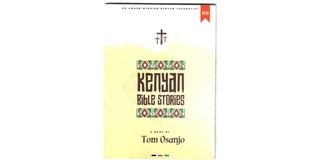Journalist tells Bible tales with a Kenyan twist

The cover of the book 'Kenyan Bible Stories' by journalist Tom Osanjo.
What you need to know:
- The publication combines humour, history, urban culture and Bible stories into one easy read.
- Old Testament characters are given not only hip nicknames but are also placed in the socio-political realities of latter-day Kenya and their circumstances then related to what they would have encountered in Kenya today.
- The journalist in the writer pops up in many instances, especially when his allusions touch on the political landscape.
Veteran journalist Tom Osanjo one day decided to add a new flavour to his social media posts. For a long time, he had been publishing posts that take an interesting look at day-to-day life.
This time, the award-winning scribe decided to gravitate towards posts about the Bible. Not just posts, but posts that make Bible stories fun.
His first update along those lines was penned after a long night of thinking. He writes that it received a rousing welcome among his followers on Facebook. Many posts would follow.
His friends found the posts intriguing and they challenged him to make a book out of them.
The result of that is a 98-page book titled Kenyan Bible Stories, a publication that combines humour, history, urban culture and Bible stories into one easy read.
It is a book that brings you, David, as Davy; Jacob as Jake; Samson as Sammy; Moses as Mosee; Joseph as Josee; Sarah as Jaber Min Isaac; among others.
Socio-political realities
Old Testament characters are given not only hip nicknames but are also placed in the socio-political realities of latter-day Kenya and their circumstances then related to what they would have encountered in Kenya today.
One example is the description of David the shepherd before he became king.
“Here I am picturing Davy walking his flock somewhere around Rongai and a lion jumps over the fence from Nairobi National Park. While the rest of the guys are running for the hills – in his case, the Ngong Hills – Davy casually faces the lion and tackles it like Undertaker of WWE, kills the lion and continues whistling for his sheep. Atta guy!”
If you want to understand deeper some of the Bible stories more and have a good laugh while at it, this is the ideal book to run your fingers through.
We can judge the book by the blurb. And our verdict is that it meets what the writer set out to do.
Part of the blurb reads: “Being careful not to err by adding or subtracting anything to the Good Book as we have been warned, the author has strived to give the reader a modern setting from the Bible.
It is the author’s hope that these familiar surroundings will be appreciated. Ultimately, the whole idea is to point the reader to greater curiosity and to read the Bible more.”
If piquing interest in the Bible is the objective, then a lot of it happens in the book. The story of the woman of the night called Rahab who helped protect Israeli spies and became a descendant of Jesus makes one want to read the narrative in full.
Jacob being described as the “original wash-wash guy” adds a new colour to the old tale of a younger brother stealing his elder brother’s inheritance. Adam and Eve being described as “the first employees to be sacked” is an invitation to re-study the book of Genesis and relive the ejection from the Garden of Eden.
Together with the generous font and an illustration per chapter, this is a book that readers of all ages will find worthwhile.
Political landscape allusions
The journalist in the writer pops up in many instances, especially when his allusions touch on the political landscape.
For instance, retired president Uhuru Kenyatta is mentioned in the rendition of the story of Elijah informing King Ahab that there wouldn’t be rain till further notice.
He is called Baba Ngina for good measure. The journey of Terah, the father-in-law of Sarah, is likened to ODM leader Raila Odinga’s promise of leading his supporters to Canaan which came a cropper. There is also a mention of UDA and Azimio in the story of Esther, among other instances.
Mr Osanjo has been a journalist with Step Africa, People Weekly (which later became People Daily), the Star, the Standard and occasionally contributes to the Nation.
“He is perhaps the only journalist whose works have appeared in all of the four local Kenyan dailies,” says the section about the author.
The book at times gets biographical, and through it, we know that the author once had his rib surgically removed. Guess where that story is shared? In a chapter about Adam and Eve.
“I am familiar with this rib removal because many years ago when I was just a few weeks old, a group of Russian doctors removed one of my ribs that had been damaged by an infection I was born with,” he writes.
In all, the people who pushed Mr Osanjo to write the book, and those who prayed for him to do it, will be proud of the outcome.
The book is available at the Writers’ Guild offices at Hazina Towers in Nairobi. It goes for Sh900.





